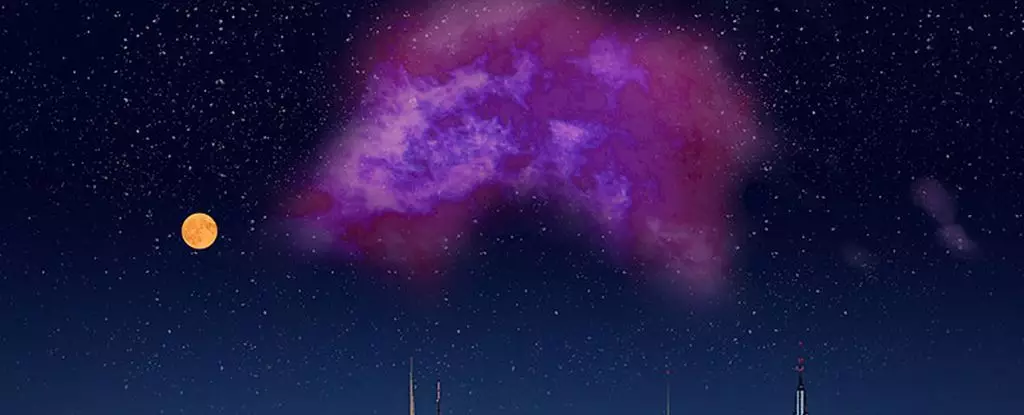In a thrilling development for astrophysics, a colossal molecular cloud named Eos has been unveiled just 300 light-years from our Solar System. This remarkable discovery, immortalized in the annals of astronomy, highlights both the potential of advanced imaging technology as well as the mysteries still lurking in the cosmos. Eos, spinning through the fringes of the Local Bubble—a cavity in the interstellar medium filled with low-density hot gas—offers researchers a unique glimpse into the foundational elements of star formation.
The revelation arises from an innovative approach to observing molecular materials in the vast emptiness of space. Instead of relying solely on traditional markers like carbon monoxide, a staple in the study of interstellar clouds, scientists have pursued a novel method that detects the fluorescence of molecular hydrogen through far-ultraviolet light. According to astrophysicist Blakesley Burkhart of Rutgers University, this breakthrough is pivotal: “This is the first-ever molecular cloud discovered by looking for far-ultraviolet emission of molecular hydrogen directly.”
The Significance of Molecular Clouds
Molecular clouds like Eos serve as crucial nursery environments for star formation, providing the raw materials and conditions necessary for stars to ignite. Yet, despite their importance, many of these clouds remain elusive to conventional observational techniques. When we gaze upon the night sky adorned with luminous stars, the vast voids in between may appear desolate. However, interstellar space is rich with molecular gas that, while often hidden from immediate view, plays a pivotal role in cosmic evolution.
The challenge of observing these molecular clouds lies within their sheer diffused nature. While some molecules like carbon monoxide make themselves known through their distinct signatures, simpler molecules like hydrogen have been notoriously difficult to detect. The approach taken by Burkhart and her team exemplifies the potential of modern science to unearth hidden phenomena lurking in the dark expanses of the universe. The use of far-ultraviolet light as a detection method may lead to a renaissance in astronomy, establishing new pathways to explore the fundamental building blocks of the cosmos.
Illuminating the Anatomy of Eos
Elucidating the structure of Eos provides significant insights into its nature. Scientists have determined that this crescent-shaped cloud spans approximately 80 to 85 light-years across, containing around 2,000 solar masses worth of hydrogen. To visualize its size, one might consider that if Eos were visible to the naked eye, it would stretch 40 times wider than the full Moon. The sheer scale of this molecular colossus presents a fascinating reminder of the expansive and sometimes unfathomable universe we inhabit.
Moreover, Eos appears to be succumbing to its stellar surroundings, undergoing a process known as photodissociation—wherein radiation from nearby stars breaks apart the molecular structure of the cloud. This process is occurring at an alarming rate, leading researchers to project that Eos could completely dissipate within roughly 5.7 million years. In cosmic terms, this is merely a moment, underscoring the transient nature of celestial bodies.
Broader Implications for our Cosmic Understanding
The discovery of Eos, bolstered by the innovative techniques used, signifies more than just the identification of another astronomical object; it marks a paradigm shift in our comprehension of the interstellar medium. Eos presents an opportunity to probe fundamental questions surrounding molecular clouds: How do these clouds form? How do they evolve and contribute to star systems? Answering these inquiries could illuminate critical aspects of galaxy formation and evolution, enhancing our grasp of the cosmos.
This advancement also paves the way for future explorations. Other hidden molecular clouds could soon be revealed through similar methodologies, broadening our understanding of the Milky Way and potentially shedding light on galaxies beyond our own. The insights gleaned from Eos are likely to catalyze a fresh wave of astronomical research, unearthing the previously veiled relationships between stellar and galactic formation.
Looking Ahead: A New Frontier in Astrophysics
As we venture further into the cosmos, the study of molecular clouds such as Eos may become elementary to not just understanding our cosmic neighborhood but also addressing the fundamental questions regarding the origins of the universe. Each new discovery represents a thread in the intricate tapestry of cosmic history, inviting us to reflect on our place within it. The imaginative potential paired with the scientific rigor embodied in this groundbreaking work could at last illuminate the dark corners of our universe, emphasizing the dynamism that fuels human curiosity and discovery in the quest for knowledge.

